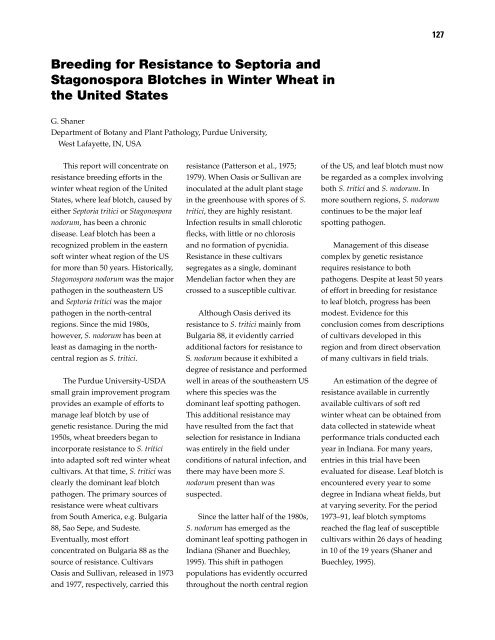Septoria and Stagonospora Diseases of Cereals - CIMMYT ...
Septoria and Stagonospora Diseases of Cereals - CIMMYT ...
Septoria and Stagonospora Diseases of Cereals - CIMMYT ...
Create successful ePaper yourself
Turn your PDF publications into a flip-book with our unique Google optimized e-Paper software.
Breeding for Resistance to <strong>Septoria</strong> <strong>and</strong><br />
<strong>Stagonospora</strong> Blotches in Winter Wheat in<br />
the United States<br />
G. Shaner<br />
Department <strong>of</strong> Botany <strong>and</strong> Plant Pathology, Purdue University,<br />
West Lafayette, IN, USA<br />
This report will concentrate on<br />
resistance breeding efforts in the<br />
winter wheat region <strong>of</strong> the United<br />
States, where leaf blotch, caused by<br />
either <strong>Septoria</strong> tritici or <strong>Stagonospora</strong><br />
nodorum, has been a chronic<br />
disease. Leaf blotch has been a<br />
recognized problem in the eastern<br />
s<strong>of</strong>t winter wheat region <strong>of</strong> the US<br />
for more than 50 years. Historically,<br />
<strong>Stagonospora</strong> nodorum was the major<br />
pathogen in the southeastern US<br />
<strong>and</strong> <strong>Septoria</strong> tritici was the major<br />
pathogen in the north-central<br />
regions. Since the mid 1980s,<br />
however, S. nodorum has been at<br />
least as damaging in the northcentral<br />
region as S. tritici.<br />
The Purdue University-USDA<br />
small grain improvement program<br />
provides an example <strong>of</strong> efforts to<br />
manage leaf blotch by use <strong>of</strong><br />
genetic resistance. During the mid<br />
1950s, wheat breeders began to<br />
incorporate resistance to S. tritici<br />
into adapted s<strong>of</strong>t red winter wheat<br />
cultivars. At that time, S. tritici was<br />
clearly the dominant leaf blotch<br />
pathogen. The primary sources <strong>of</strong><br />
resistance were wheat cultivars<br />
from South America, e.g. Bulgaria<br />
88, Sao Sepe, <strong>and</strong> Sudeste.<br />
Eventually, most effort<br />
concentrated on Bulgaria 88 as the<br />
source <strong>of</strong> resistance. Cultivars<br />
Oasis <strong>and</strong> Sullivan, released in 1973<br />
<strong>and</strong> 1977, respectively, carried this<br />
resistance (Patterson et al., 1975;<br />
1979). When Oasis or Sullivan are<br />
inoculated at the adult plant stage<br />
in the greenhouse with spores <strong>of</strong> S.<br />
tritici, they are highly resistant.<br />
Infection results in small chlorotic<br />
flecks, with little or no chlorosis<br />
<strong>and</strong> no formation <strong>of</strong> pycnidia.<br />
Resistance in these cultivars<br />
segregates as a single, dominant<br />
Mendelian factor when they are<br />
crossed to a susceptible cultivar.<br />
Although Oasis derived its<br />
resistance to S. tritici mainly from<br />
Bulgaria 88, it evidently carried<br />
additional factors for resistance to<br />
S. nodorum because it exhibited a<br />
degree <strong>of</strong> resistance <strong>and</strong> performed<br />
well in areas <strong>of</strong> the southeastern US<br />
where this species was the<br />
dominant leaf spotting pathogen.<br />
This additional resistance may<br />
have resulted from the fact that<br />
selection for resistance in Indiana<br />
was entirely in the field under<br />
conditions <strong>of</strong> natural infection, <strong>and</strong><br />
there may have been more S.<br />
nodorum present than was<br />
suspected.<br />
Since the latter half <strong>of</strong> the 1980s,<br />
S. nodorum has emerged as the<br />
dominant leaf spotting pathogen in<br />
Indiana (Shaner <strong>and</strong> Buechley,<br />
1995). This shift in pathogen<br />
populations has evidently occurred<br />
throughout the north central region<br />
127<br />
<strong>of</strong> the US, <strong>and</strong> leaf blotch must now<br />
be regarded as a complex involving<br />
both S. tritici <strong>and</strong> S. nodorum. In<br />
more southern regions, S. nodorum<br />
continues to be the major leaf<br />
spotting pathogen.<br />
Management <strong>of</strong> this disease<br />
complex by genetic resistance<br />
requires resistance to both<br />
pathogens. Despite at least 50 years<br />
<strong>of</strong> effort in breeding for resistance<br />
to leaf blotch, progress has been<br />
modest. Evidence for this<br />
conclusion comes from descriptions<br />
<strong>of</strong> cultivars developed in this<br />
region <strong>and</strong> from direct observation<br />
<strong>of</strong> many cultivars in field trials.<br />
An estimation <strong>of</strong> the degree <strong>of</strong><br />
resistance available in currently<br />
available cultivars <strong>of</strong> s<strong>of</strong>t red<br />
winter wheat can be obtained from<br />
data collected in statewide wheat<br />
performance trials conducted each<br />
year in Indiana. For many years,<br />
entries in this trial have been<br />
evaluated for disease. Leaf blotch is<br />
encountered every year to some<br />
degree in Indiana wheat fields, but<br />
at varying severity. For the period<br />
1973–91, leaf blotch symptoms<br />
reached the flag leaf <strong>of</strong> susceptible<br />
cultivars within 26 days <strong>of</strong> heading<br />
in 10 <strong>of</strong> the 19 years (Shaner <strong>and</strong><br />
Buechley, 1995).









